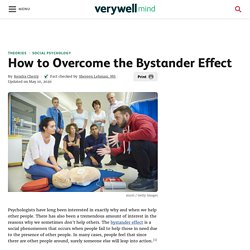

Social psychologists Bibb Latané and John Darley popularised the concept of the bystander effect following the infamous murder of Kitty Genovese in New York City in 1964. The 28-year-old woman was stabbed to death outside her apartment; at the time, it was reported that dozens of neighbours failed to step in to assist or call the police ("Bystander effect," n.d.). Darley and Latney conducted an experiment in 1968 which formed the basis of research on the bystander effect.
Therefore, these resources aim to discuss what the Bystander Effect is to the general public and how we can counteract the bystander effect.
Bystander Effect. Definition. Bystander effect, Bystander intervention, Psychology. Real life examples of the bystander effect. The murder of "Kitty" Genovese that led to the Bystander Effect & the 911 system. Catherine “Kitty” Genovese was a 28-year-old woman who was brutally murdered outside of her Queens apartment in New York City on March 13, 1964.

Genovese’s attack lasted around 30 minutes as she was stabbed 14 times by a man named Winston Moseley. It was originally reported that there were 38 bystanders who turned their back on Genovese’s early morning cries for help, shutting their doors to silence her screams. Although that judgment was later proven to be inaccurate, the murder was considered the driving force behind our emergency 911 system today and the discovery of the term that so many psychologists are still researching: “The Bystander Effect.” It was around 3 o’clock in the morning when Genovese arrived home from managing a local bar where she worked. Kitty Genovese She parked her car and started walking towards her apartment building, when she noticed a man standing at the corner end of the parking lot.
Genovese nervously kept walking. Studio photo of Catherine “Kitty” Genovese, 28. Torture and Death of Jew Deepen Fears in France. The police did not yet know the identities of the gang members but were close on their heels.

Around Feb. 10, Mr. Fofana briefly visited an Internet cafe on the Rue de la Fidélité in the 10th Arrondissement, wearing a cap and a scarf that covered his mouth and nose. "I don't even think he took his gloves off," the manager said Friday. Just 15 minutes later, he said, police officers arrived looking for a black man, a computer-generated sketch in hand. They lifted fingerprints from the keyboard Mr.
On the evening of Feb. 13, Mr. Two days later, with the case beginning to make shocking headlines, Mr. One was the 17-year-old French-Iranian believed to have lured Mr. Fearing she would be caught, Ms. When Mr. So far, a total of 19 people, ages 17 to 39, have been arrested in connection with Mr. Outrage in China after toddler run over, ignored - CNN. Gruesome footage of a toddler falling victim to two successive hit-and-run accidents and then being ignored by many passers-by at the scene last week in southern China continued to galvanize the nation Monday, prompting a fierce debate on the state of morality in Chinese society.

A security camera captured the horrific incident last Thursday outside a hardware market in Foshan, Guangdong Province. Two-year-old Wang Yue was seen toddling in the middle of a narrow street and looking around, oblivious to a fast-approaching white van. The disturbing video shows the van knocking the girl over. The driver briefly stops with the girl underneath the van, before continuing on, its rear tires slowly rolling over her small body. The girl is left barely moving in her own blood as several pedestrians and cyclists pass by. Minutes later, another small truck drives over Wang without slowing down, the video shows.
"I feel helpless and angry," the father said. Reasons for the Bystander Effect. Darley & Latane's experiment on Bystander Effect: Diffusion of Responsibility. Ethics Defined: Diffusion of Responsibility. PLURALISTIC IGNORANCE. Untitled. Bystander Intervention. How to Overcome the Bystander Effect. Psychologists have long been interested in exactly why and when we help other people.

There has also been a tremendous amount of interest in the reasons why we sometimes don't help others. The bystander effect is a social phenomenon that occurs when people fail to help those in need due to the presence of other people. In many cases, people feel that since there are other people around, surely someone else will leap into action.1 While the bystander effect can have a negative impact on prosocial behavior, altruism and heroism, researchers have identified a number of different factors that can help people overcome this tendency and increase the likelihood that they will engage in helping behaviors.2 Some of these include: Witnessing Helping Behavior Sometimes just seeing other people doing something kind or helpful makes us more willing to help others. Imagine that you are walking into a large department store. Being Observant. Bystander Revolution: Salma Hayek. BYSTANDER INTERVENTION.
The Four D's and the Do's and Don't of Bystander Intervention. Carpenter, T. [Photograph]. Everett Collection, & Rex Features. [Photograph].